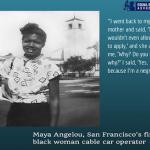San Francisco Plaza Should Be Renamed for Maya Angelou

San Francisco’s Justin Herman Plaza, formerly known as the Embarcardero Plaza, lies just in front of the Ferry Building. It honors the head of the San Francisco Redevelopment Agency during the period when it displaced thousands of low-income residents from South of Market (SOMA) and the Fillmore. This latter displacement, which critics attacked as “Negro Removal,” is as one of the darkest episodes in San Francisco history.
So why is San Francisco continuing to honor such a man?
That’s the very good question Brett Anderson and Michelle Harris and their Advocates For A Better World group is asking. They have filed a petition with Change.org to rename the area Maya Angelou Plaza.
The petition offers many reasons for the change. And it makes a lot of sense.
Maya Angelou’s SF Legacy
Maya Angelou, who died in 2014, moved to San Francisco during World War II. She won a scholarship to study dance and acting at the California Labor School, in its original location at Turk and Van Ness. The California Labor School soon moved to 240 Golden Gate in the heart of the Tenderloin, and offered a diversity of cultural and arts programs for workers that is unsurpassed to this day (the California Labor School’s contributions to San Francisco will be highlighted in the soon to open Tenderloin Museum).
Angelou also became San Francisco’s first black female cable car conductor. So for those concerned that the city would be naming someone without a connection to the plaza, that location is known for its nearby cable cars.
Maya Angelou’s storied life is the stuff of dreams. Her legacy does not depend San Francisco naming a plaza in her honor.
But renaming Justin Herman Plaza is not about enhancing the legacy of one of the most admired people of her time. Rather, it is about San Francisco reversing its wrongful honoring of a man who wrecked the lives of the powerless and instead hailing a person that reflects San Francisco’s best values.
San Francisco’s Message
Changing the name to Maya Angelou Plaza could not be more timely. An April 21 Policy Link study got much attention last week for its prediction that by 2040, San Francisco will be the “whitest county in the region.”
The projected decline in the city’s African-American population has focused on housing costs, the digital divide, and the educational achievement gap. But the displacement of thousands of African-Americans by Justin Herman and the Redevelopment Agency back in the 1960’s and 1970’s obviously has played a role in the shrinking of its numbers in the city.
Those unfamiliar with those days should understand a critical distinction in what Herman’s Redevelopment Agency did in the Fillmore and what it did in SOMA.
South of Market Redevelopment was consistent with actions across the nation whereby low-income neighborhoods adjacent to downtown business districts were targeted for “Urban Renewal.” In contrast, the Fillmore District was nowhere near downtown. Its economy had nothing to do with reviving a downtown business district.
Displacing African-Americans was Justin Herman and the Redevelopment Agency’s primary goal in bringing “urban renewal” to the Fillmore. Herman effectuated this plan in an era of rising civil rights activism, and where nobody could claim that they were unaware of the racial implications of the Agency’s actions.
Justin Herman was a ruthless displacer of the poor. He wouldn’t back down to the tenants or their advocates trying to stay in their homes, which is why downtown interests so revered him.
San Francisco sends the wrong message by continuing to honor a man identified with displacing African-Americans in the Fillmore and thousands of low-income tenants from SOMA. Maya Angelou is a far better choice.
The renaming of a plaza in her honor won’t slow the out migration of African-Americans from San Francisco, but it will send a message about San Francisco’s opposition to rather than support of, this trend.
[Randy Shaw is Editor of Beyond Chron and author of The Tenderloin: Sex, Crime and Resistance in the Heart of San Francisco.]
